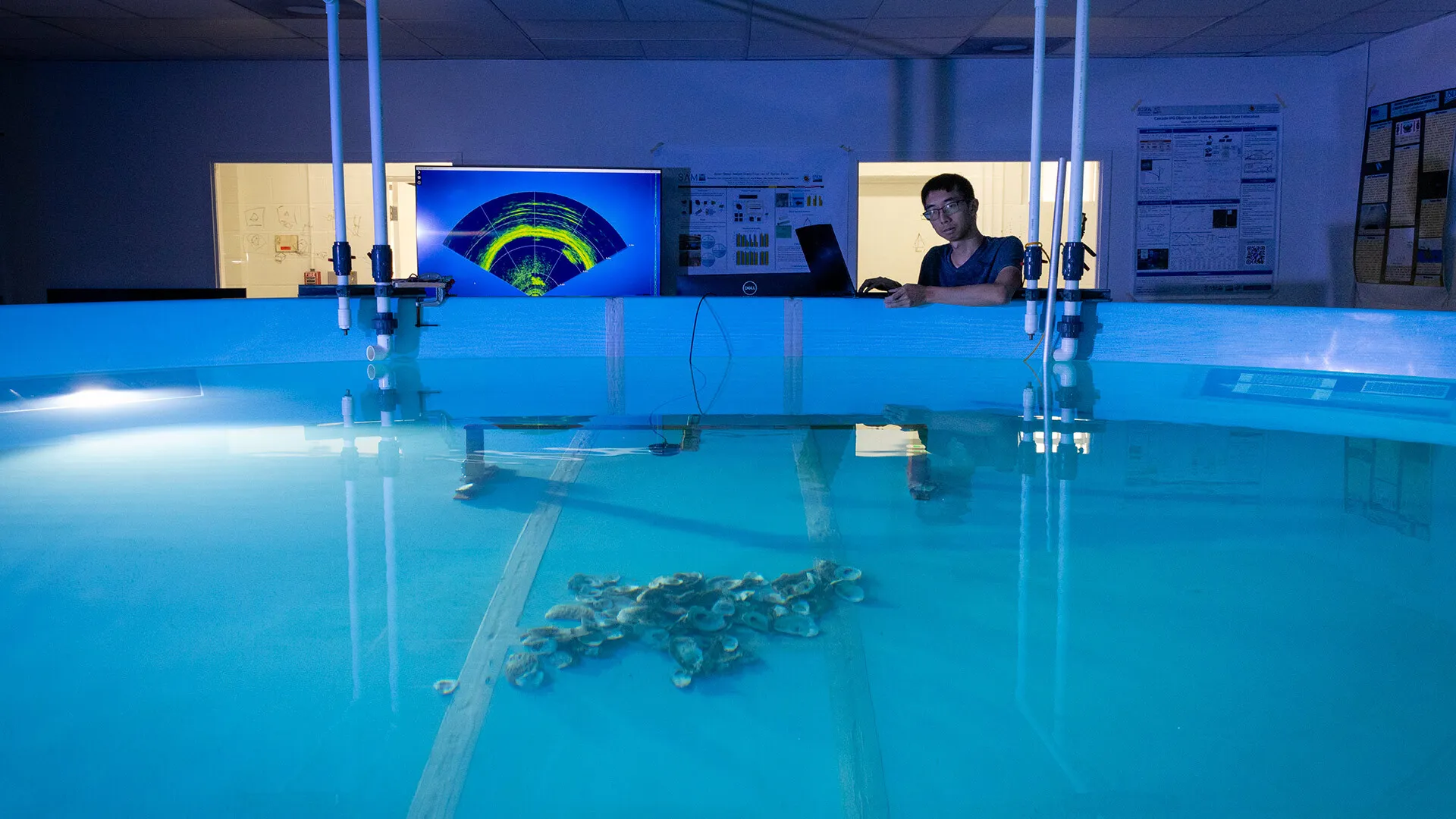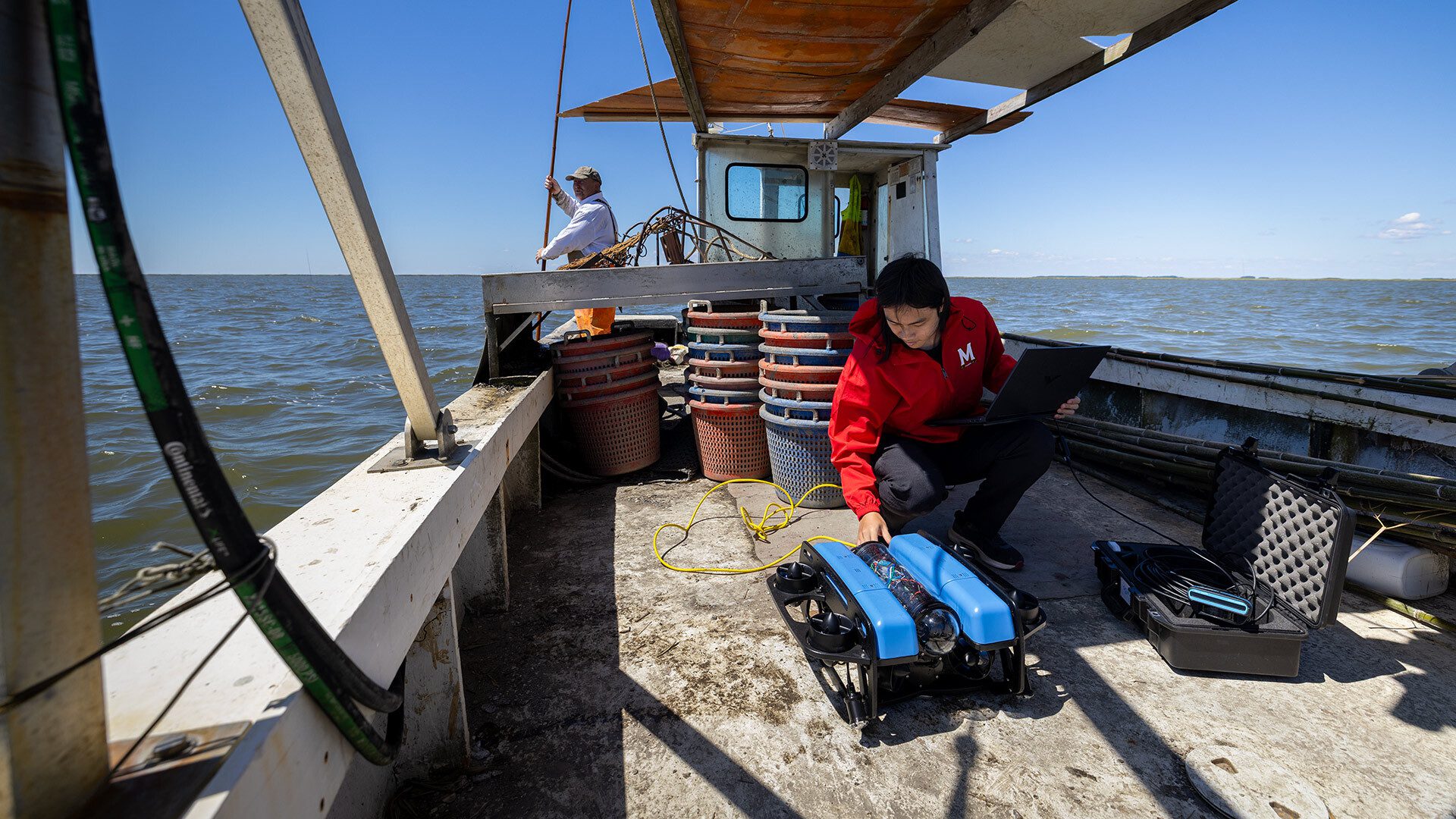- October 07, 2025
- By John Tucker
When Eric Wisner steers his boat across the Chesapeake Bay, he plunges his bamboo stick into the murky water, searching for the hard bottom terrain necessary for baby oysters to thrive while avoiding the sand and mud that gobble them up.
The tap-tap-tap strategy “is kind of caveman-ish,” the 58-year-old Nanticoke, Md., oyster farmer admitted, considering that he plants larvae across hundreds of acres of seabed. “The bamboo is only an inch in diameter, and you’re lowering it down every three feet, sometimes with the wind blowing really hard.”
Wisner’s bamboo might soon become a souvenir. A team of University of Maryland engineers and aquaculture researchers has built an artificial intelligence (AI)-trained sonar device that, when mounted to a boat’s hull, can differentiate between hard and soft sea bottom several feet below. Once fully developed, the technology could shorten Wisner’s forages exponentially.
Beyond measuring aquatic turf, the sonar beam can pierce turbid waters to locate oysters with pinpoint precision and determine their sizes—tiny ones left to grow, larger ones marked for harvest—and even differentiate the living from the dead. When attached to surface-going drones, the device can traverse dark basins with penetrating vision, charting GPS-directed courses to oyster-rich areas within a waterman’s lease from the state of Maryland, helping them increase their yields by the bushel, the researchers said.
Funded by the U.S. Department of Agriculture, the study is part of a $10 million project led by UMD to accelerate sustainable aquaculture and support a shellfish farming economy that some estimate at $350 million. Uniting robotics, AI and computer vision scholars, the multi-university group endeavors to modernize an industry that many call technologically archaic.
The UMD sonar technology was tested in Washington State’s Puget Sound and featured in a paper published in June in IEEE Xplore. The lead author, mechanical engineering Professor Miao Yu, said the breakthrough can strengthen one of Maryland’s most iconic industries while satisfying fried oyster and raw-bar aficionados region-wide with increased supplies.

Mechanical engineering doctoral student Michael Xu tests sonar imaging of oyster shells in a UMD tank. The research team he's working with plans to use sonar as part of an imaging system that will employ artificial intelligence to spot oysters in murky environments.
“We are using robotics and AI to make the whole sea bottom visible,” said Yu, whose team includes researchers from the A. James Clark School of Engineering, College of Agriculture and Natural Resources and College of Computer, Mathematical, and Natural Sciences. “If you’re a farmer who can see the oyster, you can grab the oyster.”
In recent years, harvesting fish like Atlantic salmon and catfish has relied on optical imaging, which can produce high-resolution photos of large objects in clear waters, like a sunken ship in the Atlantic. But that method fails with small targets in low-visibility environs like the Chesapeake, Yu said.
Sonar imaging, in contrast, uses sound rather than light, allowing it to ”look through” the murk, but it too has drawbacks; its low-resolution scans are difficult to decipher, especially when depicting something as small as a two-inch mollusk.
Aiming to combine optical precision with sonic reach, Yu’s team turned to AI, asking a machine to take enough scans of oysters and aquatic terrains to start perceiving the slightest of distinctions.
To develop their idea, the researchers convened at the University of Maryland Center for Environmental Science in Cambridge, Md., which boasts a hatchery. Here they separated a 10-foot-wide empty fishtank into quadrants, filled each portion with different combinations of sand, shells and live oysters to mimic a multi-terrain seafloor, and loaded the vat with cloudy water from the Chesapeake.
Next, the team affixed a sonar sensor to a stand, placed it in the water and scanned each quadrant to produce hundreds of images at varying angles and frequencies. During that process, an AI model tracked the output and fed the data into its algorithm so it could begin to recognize varying oyster sizes, densities and bottom terrains.
“The coolest part is figuring out which oysters are alive and dead, which greatly helps farmers know if their lease is ready to harvest,” said Michael Xu, a third-year doctoral student in mechanical engineering and first author of the study, who played a lead role in developing the algorithms.
After encouraging results, the researchers traveled to a Washington State coastline with aggressive, opaque tides harboring untold tons of oysters. At low tide they physically documented the creatures’ positions on hands and knees; at high tide they motored a sonar-equipped drone across the surface that measured the shellfish 5 feet below.
By the end of the test, the sensor determined oyster density and size with 75% accuracy, on average.
The results underscore the need to bring oyster farming into the 21st century, said Don Webster, a University of Maryland Extension Principal Agent focused on aquaculture and coauthor of the study. “You want to be able to see oysters as they’re growing, but right now you throw a 1830s design dredge overboard, drag some oysters to the surface and kind of look at them to see how your population is doing. It’s very primitive.”
[The Modern Battle for Maryland's Oysters]
The UMD team is conducting more tests on the Gulf Coast, in partnership with the University of Southern Mississippi. It soon will pursue another grant to lend their device to active watermen, as well as restoration specialists invested in oysters’ ecological role as a natural water filter, coastline protector and habitat provider for other marine life.
From his Nanticoke hatchery, Wisner, familiar with the sonar technology, is intrigued by what the future holds.
“Like any kind of technology that’s targeted toward your industry, this is another tool in the toolbox,” the farmer said. “More productivity, more oysters.”
UMD Research Changes Lives
At the University of Maryland, scientists and scholars come together to spark new ideas, pursue important discoveries and tackle humanity's grand challenges—improving lives in our communities and across the globe. See more examples of how UMD research changes lives at today.umd.edu/topic/research-impact.
AI at Maryland
The University of Maryland is shaping the future of artificial intelligence by forging solutions to the world’s most pressing issues through collaborative research, training the leaders of an AI-infused workforce and applying AI to strengthen our economy and communities.
Read more about how UMD embraces AI’s potential for the public good—without losing sight of the human values that power it.
